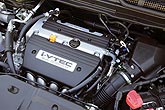Recent Articles
Popular Makes
Body Types
2007 Honda CR-V First Drive
Honda feeds the CRaVing for an efficient small SUV
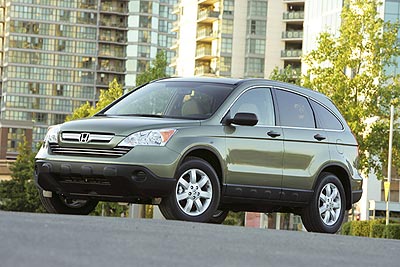
Honda CR-V – First Drive: Nothing’s better for setting one’s financial priorities straight than a good ol’ corporate layoff, or better yet, an expensive divorce. Of course, no devoted employee or loyal husband would want or deserve such harsh treatment, but in the event that such an unfortunate occasion should arise, hard decisions must be made. The importance of the almighty dollar reigns supreme, as untracked expendable income is replaced by serious contemplation over the necessity of buying name-brand milk. Drinking water suddenly springs from the kitchen tap rather than the French Alps. Similarly, sky-rocketing gas prices have drivers increasingly aware of what they need in terms of transportation. Sure, that intimidating 400-horsepower monster SUV would disperse traffic quicker than a flatulent burrito fiend could clear a room, and that hybrid crossover promises decent gains in efficiency, albeit for a hefty premium, but how much sense do either of those alternatives make, especially when Honda is offering an all-new CR-V with room for five passengers and their gear, optional four-wheel-drive traction, and real-world fuel economy into the low 30s? Plus, it can be fully decked out with a power moonroof, leather seats, and a touch-screen navigation system for less than $30,000. Not to mention it’s a Honda, so there’s a better chance than not that the redesigned 2007 CR-V will be dependable. No, this 166-horsepower ‘ute won’t rip up the pavement or tow the family pleasure boat, yet it can tug a 1,500-lb. load to the transfer station, and will provide a comfortable, somewhat entertaining ride for the active match.com user or small family. And each stop at the gas station won’t equate to an additional car payment.
Model Mix
Model Mix Priced from the low $20,000s to about $28,000 fully loaded, the 2007 Honda CR-V packs six standard airbags, plenty of power features, and options like four-wheel drive and a touch-screen navigation system with a rearview camera. Included among the changes for the 2007 Honda CR-V is a new trim, the EX-L, which replaces the SE. Carried over are the LX and EX models. As was the case for 2006, the CR-V LX is designed for the budget-conscious buyer with its low $20,000s starting price, yet it offers a long list of standard features like a five-speed automatic transmission that pushes power to either the front or all four 17-inch steel wheels; keyless entry; power mirrors, windows, and door locks; air conditioning; a tilt and telescoping steering wheel; a CD player and MP3/iPod auxiliary jack; a trip computer; an overhead conversation mirror to keep an eye on rear passengers; and a height-adjustable driver’s seat. Safety equipment runs the gamut from front side-impact and side-curtain airbags, traction and stability control systems, and a tire pressure monitor, to front active headrests. EX versions of the CR-V are priced in the mid $20,000s and include all of the LX’s features as well as a power moonroof, 17-inch alloy wheels, variable intermittent wipers, rear privacy glass, a security alarm, a six-disc CD changer, and an exterior temperature gauge. Front- and four-wheel-drive EX models are available. Residing at the top of the 2007 Honda CR-V hierarchy is the EX-L, which sells for about $26,000 in 4WD guise. Befitting its lofty position, the EX-L provides its buyer with heated mirrors, medium-grade leather upholstery, a leather-wrapped steering wheel, a center console between the front seats, heated front buckets, and XM satellite radio. Adding $2,000 to the bottom line is an optional touch-screen, GPS navigation system with voice recognition, a rearview camera, a subwoofer, and a digital card reader accessed behind the tilting display mounted in the middle of the dash. What you won’t find on the EX-L, or any 2007 CR-V for that matter, are popular items like power seats or a hideaway third-row bench. If carrying more than five passengers is a necessity, you’ll need to move up to the larger, more expensive Honda Pilot or jump over to the Toyota RAV4 or Mitsubishi Outlander.
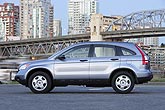
Nuts and Bolts
Nuts and Bolts The 2007 Honda CR-V draws 161 horsepower from a 2.4-liter four-cylinder engine mated to a five-speed automatic transmission. Mileage ranges from 23 city/30 highway (2WD) to 22 city/28 highway (4WD). Though there are notable exceptions like the Accord V6 and the Odyssey minivan, Honda typically chooses to power its vehicles with clean-burning engines that aim to couple adequate power with laudable efficiency. The 2007 CR-V is no exception, and as such is powered by an aluminum, 2.4-liter, four-cylinder powerplant with dual overhead cams, i-VTEC (intelligent variable valve timing and lift electronic control) technology, and a 10-percent power gain over the 2006 model. That equates to 166 horsepower at 5,800 rpm and 161 lb.-ft. of torque at 4,200 rpm, with mileage estimates between 23 city/30 highway (2WD) and 22 city/28 highway (4WD). Those figures are comparable to the redesigned Toyota RAV4’s base powerplant, though the Toy’s optional 269-horsepower V6 offers 103 extra ponies with a negligible hit to EPA-rated fuel economy. Korean competitors like the Kia Sportage and the updated Hyundai Santa Fe also pack more optional punch under the hood, though they suffer in terms of efficiency. The CR-V’s emissions have been upgraded from LEV II LEV to LEV II ULEV, or from clean to cleaner, and last year’s five-speed manual transmission has been deleted from the lineup – every 2007 Honda CR-V comes with a five-speed automatic transmission, without a manual or sport shifting mode. Again, numerous other small suvs address this concern. Honda’s Real Time 4WD, which without a low range or any input from the driver is essentially an all-wheel-drive system, is available on all trims and adds a little more than 100 pounds to the curb weight. Otherwise, the CR-V is a front-driver that tips the scales at about 3,400 pounds, which is a few hundred pounds less than a top-of-the-line Toyota RAV4. That heft is suspended by MacPherson struts up front and a multi-link setup bolted to the rear, with added control courtesy of front and rear stabilizer bars. The steering system is of the variable-assisted rack-and-pinion variety, while braking is the focus of four-wheel antilock discs aided by electronic brake distribution and electronic brake assistance systems. Bridgestone Dueller H/T 225/65R17 tires, up from 2006’s 16 inchers, connect each 2007 CR-V to the road. A tow capacity of 1,500 pounds remains unchanged, lagging behind the Subaru Forester (up to 2,400 pounds), the Toyota RAV4 (up to 3,500 pounds), and the Chevrolet Equinox (standard 3,500 pounds).
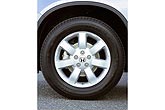
Design
Design Honda’s redesigned CR-V is shorter and lower than its predecessor, offers cargo space nearly identical to the new Toyota RAV4, yet looks remarkably similar to the 2007 Acura RDX. If a look at the 2007 Honda CR-V has you thinking of the new Acura RDX SUV, there’s good reason – the designers of each apparently share office space. According to Honda, the two vehicles are completely separate, though they appear remarkably similar, at least in terms of their overall shapes. However, take a minute to really analyze the details and you’ll notice that the Honda features arched rear glass as opposed to the Acura’s squared windows, the CR-V’s tail end is rounder, its face is more square and upright, and the interior differs with a unique dash and a shift knob below the instrument panel rather than on the center console. What both models share is a sloping roof line, marking a definite departure from the boxy cargo area of the 2006 CR-V, and contoured side body panels that feed into gently flared wheel arches. When all is said and done, the only visual cues that tie the old and new CR-V together are those Volvo-style vertical taillights. Along with the redesign come a few pros and cons. Among the few negatives are visibility that’s somewhat hampered by wide rear pillars and a ride that, while quiet, still allows its share of road and engine noise to penetrate the cabin. On the plus side, the doors open wider and the floor sits lower to the ground for easier entry and exit, the ride seems to be a bit quieter, and ergonomics are improved with the emergency brake changed from a handle on the dash to a pedal on the floor. Important from a safety aspect, Honda’s Advanced Compatibility Engineering (ACE) body structure is now a CR-V feature, one that is designed to better distribute crash energy and improve compatibility with other vehicles in the event of a frontal collision, the payoff for which is added safety for the occupants. Notable to anyone familiar with the CR-V are the changes to the rear – the tailgate now rises instead of opening from left to right (an annoyance for existing CR-V and 2006 Toyota RAV4 owners who wish to unload cargo while parked with the passenger’s side against the curb), there are three grab handles on the inside of the gate and on the lower edge, and the spare tire has been relocated from the exterior to inside below the cargo floor. Moving the spare cut about three inches from the 2007 CR-V’s length (and should lessen rear-impact repair costs). Other altered dimensions include a lower ground clearance that trades a bit of off-road ability for improved stability and handling; a wheelbase that has been shortened and a track that has been widened, again for improved stability and handling; and the new design affords minor gains in cargo (within 0.1 inch of the RAV4) and hip room, though negligible losses are realized in the areas of rear leg and head room, or roughly an inch less than the Toyota RAV4. Slightly less space for ten toes and big heads aside, the 2007 Honda CR-V’s rear seat is an inviting space thanks to comfortable cushions, a reclining back rest, as well as easy ingress and egress. In addition to its 60/40 tumble-and-fold configuration which increases cargo capacity from 35.7 to 72.9 cubic feet, the rear split bench slides forward to put a center-mounted child seat within the driver’s or front passenger’s reach (up to three child seats can be accommodated) and a fold-down center armrest provides two cupholders. Very little serves to separate the 2007 Honda CR-V trims. The LX is decorated with a black grille, black mirrors, and black door handles; while the EX and EX-L get a chrome grille, alloy wheels, and body-color door handles. Furthermore, EX and EX-L models feature a rear shelf with a 20-lb. capacity that can be removed to sit flush on the cargo floor. Visible only when the tailgate is raised, a black bumper pad is used on all models to prevent scratching when loading or unloading cargo. Affixed to the interior of every 2007 CR-V are a variety of materials like alloy-ish trim on the doors and instrument panel, pimpled plastic on the dash cap, and multiple grain patterns throughout.

Driving Impressions
Driving Impressions Enthusiasts will wish for more power and some sort of control over the automatic transmission. Everyone will appreciate the CR-V’s comfortable ride, efficiency, and refined engine. There’s one irrefutable fact that anyone test driving a 2007 Honda CR-V will quickly notice: This rig feels sluggish off the line. Those 166 horses are acceptable, actually more than sufficient for around town or highway cruises, but they’re late to gain steam when spurred and are hindered by a transmission that often fails to drop down a sufficient number of gears to put the engine into the meat of the rev range. The tranny is designed to learn and adapt to the driver’s style, but a more direct and effective approach would be to add a sport or manual shift mode that affords the master behind the wheel more control over how high the tachometer needle climbs and when it moves, especially since the five-speed manual with an old-fashioned clutch pedal has been scrapped. To its credit, the 2.4-liter four-banger remains relatively composed at high revs, offering Honda’s typical level of lofty refinement, and the transmission wasn’t shy about shifting, a point appreciated even if there were frequent hunts for the appropriate gear. However, in terms of overall performance, several competitors look to have the CR-V beat before it even hits the street. If this all sounds extremely negative, it shouldn’t – many of these minor gripes could be eradicated with a slight injection of power, yet that would jeopardize the CR-V’s estimated 28-30 mpg highway rating. For the record, our drive from the city of Vancouver up to Whistler, British Columbia in an EX-L 4WD yielded fuel economy in the low 20s, whereas the mostly downhill return run, courtesy of an LX 2WD model, averaged closer to 31 mpg. Those are fairly accurate figures since steady traffic limited us to reasonable speeds. However, opportunities are meant to be made, so when spots opened between slower motorists and tight corners availed themselves, we took advantage. High-speed cornering may be a bit beyond the 2007 Honda CR-V’s reach, yet tossing it gently into a sweeper is a worry-free endeavor, aided no doubt by the 17-inch rubber and nicely-weighted, communicative steering. The wider track and lower center of gravity help give the CR-V a more stable, hunkered-down feel, and the updated suspension does a commendable job of controlling body roll, if not altogether removing it, while also providing a comfortable ride unaffected by bumps in the road. Suggested improvements number only a few, and considering we drove the 2007 CR-V a few months before its official launch, it’s possible these few minor wrinkles may be ironed out before this redesigned SUV lands in your town. Besides adding more power and tweaking the transmission’s shift points, we’d like brakes that are equally effective yet easier to modulate, a bit more road feel added to the steering, and tires that remain quiet and maintain traction better during hard cornering. No, the CR-V isn’t intended to be a pavement-carving rally car, but we’re talking about a wish list here – might as well go for the gold.
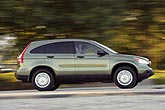
FAQs
FAQs The 2007 Honda CR-V, expected to achieve top-notch crash-test ratings, will see some models built in the U.S. and beats new rivals like the Mazda CX-7 on the fuel economy and cargo room fronts, though it loses the horsepower race. How does the 2007 Honda CR-V compare to the 2007 Mazda CX-7? Both are priced from the low $20,000s, though tacking on options can carry the Mazda CX-7 beyond the CR-V’s estimated $28,000 price ceiling. The Mazda uses a turbocharged engine to add 80 horsepower and nearly 100 extra lb.-ft. of torque, though it subsequently lags in fuel economy and requires premium petrol. Cargo capacity is markedly less in the CX-7, though its 2,000-lb. tow capacity allows it to tug 500 pounds more than the Honda CR-V. How much of the Honda CR-V is shared with the similar 2007 Acura RDX? Honda officials are a bit tight-lipped about the details, but they did tell us that despite the visual similarities, the Honda CR-V and Acura RDX share only about seven percent of their parts. The dimensions are largely different, and the underpinnings and powertrains are unique. Surprisingly, the Honda Civic actually shares more with the 2007 CR-V at roughly nine percent. Is the 2007 Honda CR-V a safe vehicle? Crash test scores have yet to be released at this writing, though Honda anticipates a five-star score from the National Highway Traffic Safety Administration (NHTSA) and a Top Safety Pick rating from the Insurance Institute for Highway Safety (IIHS). Standard safety equipment includes front-side and side-curtain airbags, the ACE body structure, active headrests, and more.
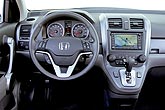
Specifications
Specifications Competitors for the 2007 Honda CR-V include the Chevrolet Equinox, Ford Escape, Hyundai Santa Fe, Hyundai Tucson, Jeep Compass, Jeep Patriot, Kia Sorento, Kia Sportage, Land Rover LR2, Mazda CX-7, Mitsubishi Outlander, Pontiac Torrent, Saturn VUE, Subaru Forester, Subaru Outback, Suzuki Grand Vitara, and Toyota RAV4 Test Vehicle: 2007 Honda CR-V Base Price: Low $20,000s to about $28,000 Engine Size and Type: 2.4-liter four-cylinder Engine Horsepower: 166 at 5,800 rpm Engine Torque: 161 lb.-ft. at 4,200 rpm Transmission: Five-speed automatic Curb Weight, lbs.: 3,389 (LX 2WD); 3,549 (EX-L 4WD) EPA Fuel Economy (city/highway): 23/30 mpg (2WD); 22/28 mpg (4WD) Length: 178 inches Width: 71.6 inches Wheelbase: 103.1 inches Height: 66.1 inches Legroom (front/rear): 41.3/38.5 inches Headroom (front/rear): 40.9/38.6 inches (LX); 38.9/38.5 inches (EX, EX-L) Max. Seating Capacity: Five Max. Cargo Volume: 72.9 cubic feet Max. Towing Capacity, lbs.: 1,500 Ground Clearance: 7.3 inches Competitors: Chevrolet Equinox, Ford Escape, Hyundai Santa Fe, Hyundai Tucson, Jeep Compass, Jeep Patriot, Kia Sorento, Kia Sportage, Land Rover LR2, Mazda CX-7, Mitsubishi Outlander, Pontiac Torrent, Saturn Vue, Subaru Forester, Subaru Outback, Suzuki Grand Vitara, Toyota RAV4
Photos courtesy of American Honda
